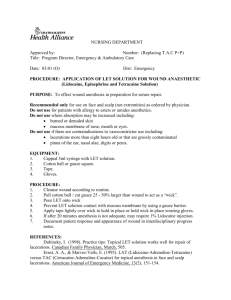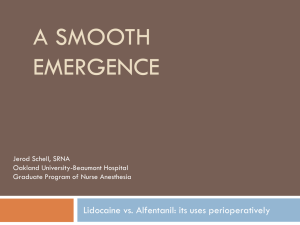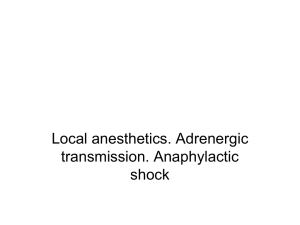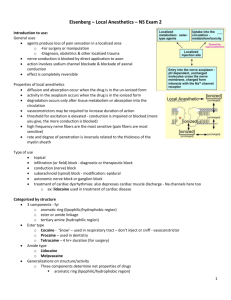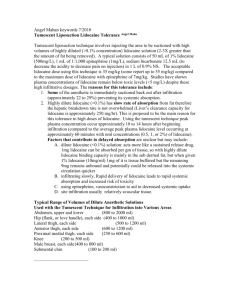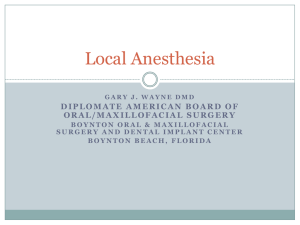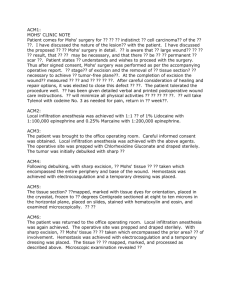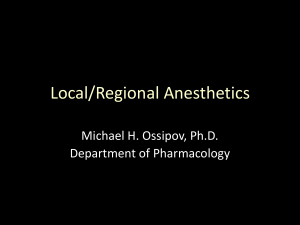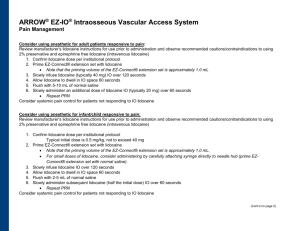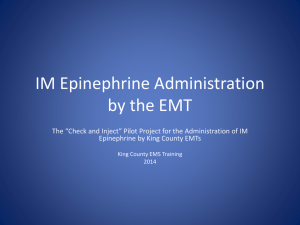practical pearls for nearly painless local anesthesia
advertisement
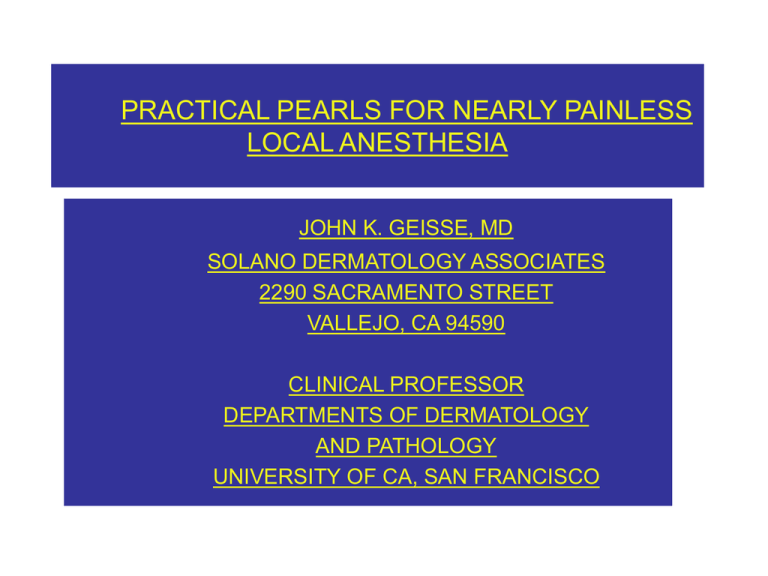
PRACTICAL PEARLS FOR NEARLY PAINLESS LOCAL ANESTHESIA JOHN K. GEISSE, MD SOLANO DERMATOLOGY ASSOCIATES 2290 SACRAMENTO STREET VALLEJO, CA 94590 CLINICAL PROFESSOR DEPARTMENTS OF DERMATOLOGY AND PATHOLOGY UNIVERSITY OF CA, SAN FRANCISCO PRACTICAL PEARLS FOR NEARLY PAINLESS LOCAL ANESTHESIA 1. PREMEDICATION: A. Anxiety 1. Benzodiazepines: PO or sublingual * IV precautions with sublingual B. Narcotics 1. PO Codeine/hydrocodone acetaminophen compounds 2. IM narcotics need IV precautions a. Naloxone, epinephrine, and crash cart C. Antiemetics 1. PO or IM hydroxyzine no longer available have not found a substitute yet D. VALIUM 5-10 MG SL PLUS RARELY DEMEROL 50-100 MG FOR PROLONGED OR DIFFICULT CASES. II. TOPICAL ANESTHETICS A. Benzocaine compounds: Intraoral or mucosal 1. Pina Colada B. Lidocaine gels and EMLA 1. Prior to needle puncture, laser therapy and dermabrasion. III. Local Anesthesia A. Lidocaine +/- epinephrine. 1. Buffered: 1 part sodium bicarbonate (8.4% or 1 mEq/ml) to 9 (10) parts 1% lidocaine with epinephrine 1:200,000. B. Longer acting anesthetics relative to lidocaine: 1. Mepivacaine: faster, longer, and safer. $$ 2. Prilocaine: slow, methemogobinemia. 3. Bupivacaine: slower, longer (up to 4 hr. block). 4. Etidocaine: ideal, better than bupivacaine. $$ A. Toxicity: 1. Allergy; very rare to amides; usu vasovagal 2. Systemic side effects: CNS, cardiovascular, pregnancy-toxicity to fetus 3. Maximum recommended dosages: a. Lidocaine with epinephrine: Adults; 7.5 mg/kg, 500 mg total (50 ml of 1% with epi; only 25ml without epi) Children; 1.5-2.5 mg/kg (0.5% recommended) 4. Epinephrine and Beta Blockers; dilute to 1:200,000 (hypertensive crisis, headache) . Most “toxicity” is from the epinephrine effect REMEMBER: LIDOCAINE TOXICITY IS NOT LINEARLY DOSE RELATED 1. E.G. 2% lidocaine has greater toxicity than 1% without significantly greater efficacy (50ML 1% Lido= 12ML 2% Lido) 2. 2% for blocks only 3. 0.5% LIDO FOR CHILDREN OR LARGE VOLUMES 4. Tumescent anesthesia has different parameters; absorption peak 12hrs D. Alternatives: – – – 1. Diphenhydramine (12.5-5-25mg/ml) with epinephrine 1; 200,000. a. sedation 2. Normal Saline preserved with benzyl alcohol a. can add epi for prolonged effect 3. Refrigerant sprays and ice cubes. IV. INJECTION TECHNIQUE A. Regional Blocks: 1. Trigeminal 2. Digital: Beware of vascular compromise, metacarpal method preferred B. Subcutaneous vs. Intradermal injection: * AVOID: Hurried anxiety producing behavior; Sudden needle sticks (the “stab” technique); Forceful or rapid tissue infiltration causing tissue distension, especially with intradermal injection; Injection of plantar/palmer surfaces (use blocks and lateral approaches); Avoid hitting bone with the needle A. “Painless Anesthesia” 1. 30 gauge needles; 1 inch long 2. Injection through cutaneous pores 3. Slow, careful infiltration; infiltrate as one advances the needle slowly, subq first 4. Distraction: massage or vibration; an assistant who “hand holds” and chats with the patient 5. Buffered lidocaine and freshly mixed epinephrine 6. Reinject in anesthetized areas; minimize sticks * Painful experiences and poor or prominent surgical scars are the two most memorable aspects of a surgical procedure for a patient. If one can provide a nearly painless surgical procedure without the use of general anesthesia than you have won half the battle. References 1. Auletta MJ, Grekin RC: Local Anesthesia For Dermatologic Surgery. From the series Practical Manuals In Dermatologic Surgery, Churchill Livingstone, 1990. 2. Grekin RC, Auletta MJ: Local Anesthesia in Dermatologic Surgery. J AM Acad Deramtol 19:599, 1988. 3. McKay W, et al: Sodium bicarbonate attenuates pain on skin infiltration with lidocaine with or without epinephrine. Anesthesia Analogues pp. 572-574, 1987. 4. Stewart JH, et al: Neutralized Lidocaine with epinephrine for local anesthesia. J Dermatol Surg Oncol 15:10, 1989 5. Ashinoff R, Geronemus RG: Effect of the topical anesthetic EMLA on the Efficacy of pulsed dye laser treatment of port-wine stains. J Dermatol Surg Oncol 16:11, 1990. 6. Lahteenmaki T, et al: Topical analgesia for the cutting of split-skin grafts: a multicenter comparison of two doses of a lidocaine/prilocaine cream. Plastic and Reconstr Surg 82:3, 1988. 7. Physicians Desk Reference, 45th edition, 1991. 8. Bennett RG: Fundamentals of Cutaneous Surgery, C.V. Mosby Company, 1988. 9. Larson PO, et al: Stability of Buffered Lidocaine and Epinephrine Used for Local Anesthesia. J Dermatol Surg. Oncol 1991; 17:411-414.
